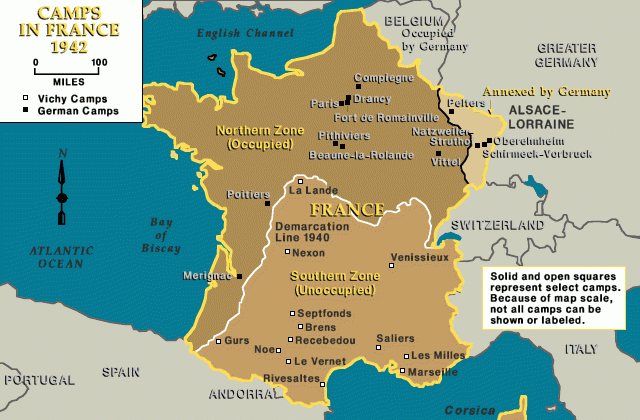
Vittel
Background
The German military command in occupied France established the Vittel internment camp in 1941. The camp was located in a resort in the Vosges Mountains of France near the German border.

The Germans used the camp primarily to house British and American citizens residing in France. Eventually, the SS also sent to the Vittel camp Jewish prisoners from outside France as hostages to exchange for German citizens interned abroad. Most of Vittel's Jewish detainees were deported to Auschwitz and murdered there in 1944.
A Model Internment Camp
After defeating France in June 1940, the Germans interned British civilians residing in the country in prisoner-of-war (POW) camps where conditions were deplorable. Reportedly in response to British threats to send German prisoners to northern Canada, the Germans established an internment camp in the resort town of Vittel. The first detainees—2,060 women, children and elderly British civilians—arrived on May 1, 1941. United States civilian detainees joined them in 1942. The camp's maximum population was about 3,000.
Interniertenlager (Ilag or internment camp) Vittel belonged to the complex of German POW camps designated Frontstalag 194. It was commanded by Captain Otto Landhauser of the German army. Vittel differed significantly from other camps in terms of living conditions, however. It consisted of a variety of hotels and a large park, all surrounded by barbed wire and constantly patrolled by armed guards. The hotels, where the prisoners lived and did their own cooking, had heat and running water.
Prisoners could send and receive mail, receive visitors, and supplement their meager rations with Red Cross packages, which also supplied items they could barter with local inhabitants. They did not perform forced labor and were permitted to organize classes and lectures. The camp had tennis courts, a library, a hospital, and stores for shopping. On the weekend, films were shown, and there were theater performances during the week.
The Germans published photos and press stories about Vittel to showcase it as representative of conditions at German camps.
Jewish Hostages at Vittel
The Germans hoped to exchange the citizens of enemy countries in German internment camps for German citizens interned abroad. In addition to those being held in British Commonwealth countries, thousands more German citizens came under internment in 1942 after the United States entered the war and most Latin American nations broke relations with the Axis powers.
Because the number of interned German citizens was far higher than the number of non-Jewish enemy citizens under German control, the German Foreign Office proposed to the SS that it exempt Jewish citizens of enemy states from the “Final Solution” measures and hold them separately for potential exchange. SS chief Heinrich Himmler agreed that Jews with strong ties to enemy states could be valuable hostages who might be exchanged for German citizens or for much-needed foreign currency.
Days before the July 1942 mass deportations from the Warsaw ghetto, the German authorities called on Jewish ghetto residents with foreign citizenship to report for possible exchange abroad and then housed them in the Pawiak Prison. These Jews' exemption from the deportations set off a frantic effort to obtain foreign citizenship papers that could save additional Jews. Hundreds of Jews obtained letters from Latin American consuls in Switzerland promising their country's citizenship. The Germans understood these papers were probably not valid but decided to honor them temporarily in case the Jews holding them could be exchanged.
A transport of about 200 Jews arrived at Vittel from Poland in January 1943, followed by another 60 Jews from Poland in May 1943. Most of these Jews held citizenship papers or promises of citizenship from Latin American countries.
Additional Jews with citizenship papers from enemy states came to Vittel from German-occupied western Europe. The Jews were housed in a separate area of the camp from the non-Jewish internees but under similar living conditions, which were far superior to those they had experienced prior to arriving.
When the Latin American states showed little inclination to negotiate exchanges or honor the citizenship papers issued to Jews by their consuls, German authorities decided to stop accepting the papers. In September 1943, a special German commission arrived at Vittel to inspect the documents held by Jewish internees claiming Latin American citizenship. Alerted by the Vittel prisoners, humanitarian and Jewish organizations sought—including through Vatican intervention—to persuade the Latin American countries to honor the documents issued to Jews.
That recognition finally came on May 31, 1944, too late for some 250 Jewish detainees at Vittel, who were sent to Auschwitz and gassed there earlier the same month. Among them was the noted poet, playwright, and teacher Itzhak Katzenelson, who had arrived at Vittel from Warsaw in May 1943. While at Vittel, he wrote the poem “Song of the Murdered Jewish People,” which was buried in the park and recovered after the camp's liberation.
Some Jewish internees were exchanged to the United States and Great Britain in 1944. Among the Americans was Mary Berg, whose diary became the first wartime published eyewitness account in English of life in the Warsaw ghetto and the deportation of its inhabitants to be murdered at Treblinka.
Liberation
Free French forces liberated the Vittel camp on September 12, 1944. An estimated 300 Jews interned at Vittel did not survive the war, most of them killed at Auschwitz.

